| Listing 1 - 7 of 7 |
Sort by
|
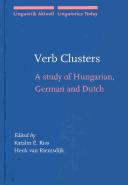
ISBN: 9027227934 1588115070 9786612160516 1282160516 902729559X 9789027227935 9789027295590 9781282160514 6612160519 Year: 2004 Volume: 69 69 Publisher: Amsterdam Philadelphia J. Benjamins
Abstract | Keywords | Export | Availability | Bookmark
 Loading...
Loading...Choose an application
- Reference Manager
- EndNote
- RefWorks (Direct export to RefWorks)
Many languages have constructions in which verbs cluster. But few languages have verb clusters as rich and complex as Continental West Germanic and Hungarian. Furthermore the precise ordering properties and the variation in the cluster patterns are remarkably similar in Hungarian and Germanic. This similarity is, of course, unexpected since Hungarian is not an Indo-European language like the Germanic language group. Instead it appears that the clustering, inversion and roll-up patterns found may constitute an areal feature. This book presents the relevant language data in considerable detail, taking into account also the variation observed, for example, among dialects. But it also discusses the various analytical approaches that can be brought to bear on this set of phenomena. In particular, there are various hypotheses as to what is the underlying driving force behind cluster formation: stress patterns, aspectual features, morpho- syntactic constraints? And the analytical approaches are closely linked to a number of questions that are at the core of current syntactic theorizing: does head movement exist or should all apparent verb displacement be reduced to remnant movement, are morphology and syntax really just different sides of the same coin?
German language --- Verb phrase. --- Dutch language --- Hungarian language --- Magyar language --- Finno-Ugric languages --- Flemish language --- Netherlandic language --- Germanic languages --- Verb phrase --- German language - Verb phrase.
Book
ISBN: 9781118358733 1118358732 Year: 2017 Publisher: [Hoboken, NJ] : Wiley Blackwell,
Abstract | Keywords | Export | Availability | Bookmark
 Loading...
Loading...Choose an application
- Reference Manager
- EndNote
- RefWorks (Direct export to RefWorks)
An invaluable reference tool for students and researchers in theoretical linguistics, The Wiley Blackwell Companion to Syntax has been revised and expanded to incorporate the last 10 years of syntactic research. As with the first edition, which was hailed for the breadth and depth of its coverage, this edition charts the development and historiography of syntactic theory with coverage of a large number of subdomains of syntax. It contains over 120 chapters that explain, analyze, and contextualize important empirical studies within syntax over the last 50 years.
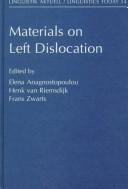
ISBN: 9027227357 1556192339 9027282366 9786613234247 1283234246 9789027282361 9781556192333 9789027227355 9027227557 Year: 1997 Volume: 14 Publisher: Amsterdam Philadelphia J. Benjamins Pub. Co.
Abstract | Keywords | Export | Availability | Bookmark
 Loading...
Loading...Choose an application
- Reference Manager
- EndNote
- RefWorks (Direct export to RefWorks)
Materials on Left Dislocation consists of two parts. Part I contains a selection of the main texts on which our present understanding of the Left Dislocation construction is based. For various reasons most of these texts had never been published, or are published in obsolete places. These articles, by Van Riemsdijk & Zwarts, Rodman, Hirschbuehler, Vat, Cinque and Zaenen, contain the first arguments that pertain to the major questions about Left Dislocation (for example whether movement or base-generation is involved), and they present the rationale for the now standard distinctions betw
Generative grammar --- Grammar, Comparative and general --- Grammaire générative --- Syntaxe --- Syntax --- 801.56 --- 801.56 Syntaxis. Semantiek --- Syntaxis. Semantiek --- Generative grammar. --- Grammar, Comparative and general -- Syntax. --- Grammar.
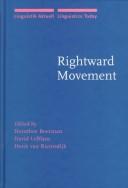
ISBN: 9027227381 1556199015 128323422X 902728234X 9786613234223 Year: 1997 Publisher: Amsterdam ; Philadelphia : John Benjamins Pub. Co.,
Abstract | Keywords | Export | Availability | Bookmark
 Loading...
Loading...Choose an application
- Reference Manager
- EndNote
- RefWorks (Direct export to RefWorks)
Symmetries and asymmetries have always played an important role in linguistic theorizing. From the early works on potentially universal properties of transformational processes, differences between rightward and leftward movement processes were noted and constituted a challenge to theories of conditions on transformations. The upward boundedness of extraposition rules vs. the successive cyclic character of question word movement, for example, remains a vexing problem. An idea which has gained considerable prominence in the most recent syntactic work, in particular Noam Chomsky's 'Minimalist Pr
Order (Grammar) --- Generative grammar --- Ordre (Grammaire) --- Grammaire générative --- Generative grammar. --- Grammar, Comparative and general --- Grammar, Generative --- Grammar, Transformational --- Grammar, Transformational generative --- Transformational generative grammar --- Transformational grammar --- Psycholinguistics --- Linear ordering (Grammar) --- Ordering constraints (Grammar) --- Sequence (Linguistics) --- Derivation
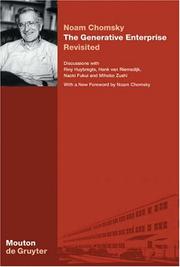
ISBN: 3110180014 3110902443 9783110902440 9783110180015 Year: 2004 Publisher: Berlin New York Mouton de Gruyter
Abstract | Keywords | Export | Availability | Bookmark
 Loading...
Loading...Choose an application
- Reference Manager
- EndNote
- RefWorks (Direct export to RefWorks)
Spanning more than two decades of thinking about generative approaches to Universal Grammar, the two interviews with Noam Chomsky in this book permit a rare and illuminating insight into his views on numerous issues in linguistics and beyond. The first discussion dates from the early days of the so-called Government Binding Theory, the second one took place after a decade of Minimalism. Thereby the evolution and the dynamics in linguistic theorizing are dramatically revealed. Scholars of grammar, cognitive scientists, philosophers will profit by reading this book, but anyone with an ardent
Generative grammar. --- Linguistics. --- Generatieve spraakkunst --- Generative grammar --- Grammaire générative --- Grammaire transformationnelle --- Grammar [Comparative and general ] -- Derivation --- Grammar [Generative ] --- Grammar [Transformational ] --- Grammar [Transformational generative ] --- Grammatica [Generatieve ] --- Grammatica [Transformationele ] --- Langage [Sciences du ] --- Langage [théorie du ] --- Linguistic science --- Linguistics --- Linguistique --- Linguïstiek --- Science of language --- Sciences du langage --- Spraakkunst [Generatieve ] --- Spraakkunst [Transformationele ] --- Taalkunde --- Taalwetenschap --- Théories du langage --- Transformational generative grammar --- Transformational grammar --- Transformationele grammatica --- Transformationele spraakkunst --- Transformationele taaltheorie --- 801.56 --- 801.56 Syntaxis. Semantiek --- Syntaxis. Semantiek --- Grammar, Comparative and general --- Grammar, Generative --- Grammar, Transformational --- Grammar, Transformational generative --- Derivation --- Language and languages --- Psycholinguistics
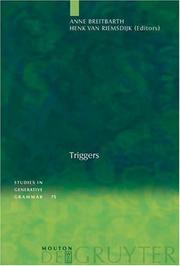
ISBN: 3110181398 9786613396495 1283396491 311019743X Year: 2008 Publisher: De Gruyter
Abstract | Keywords | Export | Availability | Bookmark
 Loading...
Loading...Choose an application
- Reference Manager
- EndNote
- RefWorks (Direct export to RefWorks)
The concept of 'trigger' is a core concept of Chomsky's Minimalist Program. The idea that certain types of movement are triggered by some property of the target position is at least as old as the notion that the movement of noun phrases to the subject position is triggered by their need to receive nominative case. In more recent versions of syntactic theory, triggering mechanisms are thought to regulate all of movement. Furthermore, a quite narrow range of triggering mechanisms is permitted. As is to be expected, such a restrictive approach meets a variety of difficulties. Specifically, the question is whether all triggering elements required to cover displacement of all kinds in natural language can be independently motivated. Further, how can a trigger theory, which crucially relies on the idea that all movement is obligatory, deal with apparently optional movement processes? Are features an adequate means to express the triggering function in all cases? More radically, are all movement phenomena really the result of the checking of trigger features? And what about apparent triggering factors that are 'external' to syntax such as prosody - can they be captured in a rigid trigger theory? In other words, could certain aspects of triggered movement be due to interface conditions? Such is the range of questions addressed by the fourteen contributions to this book. They cover a considerable range of languages (including Afrikaans, Breton, Bulgarian, Dutch, English, French, German, Gungbe, Hungarian, Italian, Japanese, Kiswahili, Romanian). These papers present materials, both empirical and theoretical, that will not fail to have considerable impact on the further development of the concept of trigger in syntactic theory.
Grammar, Comparative and general --- Language and languages --- Syntax --- Grammar --- Linguistics. --- Syntax. --- Linguistic science --- Science of language --- Linguistics --- Philology --- Grammar, Comparative and general Syntax
Book

ISBN: 1501506927 9781501506925 1501506862 9781501506864 9781501514654 1501514652 Year: 2018 Publisher: Berlin Boston
Abstract | Keywords | Export | Availability | Bookmark
 Loading...
Loading...Choose an application
- Reference Manager
- EndNote
- RefWorks (Direct export to RefWorks)
This volume explores the continuing relevance of Syntactic Structures to contemporary research in generative syntax. The contributions examine the ideas that changed the way that syntax is studied and that still have a lasting effect on contemporary work in generative syntax. Topics include formal foundations, the syntax-semantics interface, the autonomy of syntax, methods of data analysis, and detailed discussions of the role of transformations. New commentary from Noam Chomsky is included.
E-books --- Grammar, Comparative and general --- Generative grammar. --- LANGUAGE ARTS & DISCIPLINES / Linguistics / General. --- Grammar, Generative --- Grammar, Transformational --- Grammar, Transformational generative --- Transformational generative grammar --- Transformational grammar --- Psycholinguistics --- Language and languages --- Syntax --- Syntax. --- Derivation --- Chomsky, Noam. --- Generative syntax. --- Linguistics --- Philology --- Grammar, Comparative and general Syntax --- Chomsky. --- Generative Syntax.
| Listing 1 - 7 of 7 |
Sort by
|

 Search
Search Feedback
Feedback About UniCat
About UniCat  Help
Help News
News